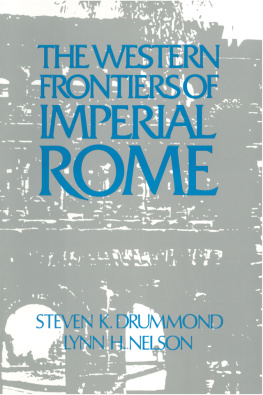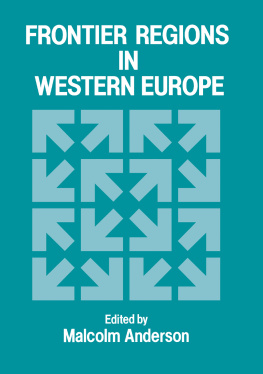THE WESTERN FRONTIERS OF IMPERIAL ROME
The Western Frontiers of Imperial Rome
Steven K. Drummond
Lynn H. Nelson
First published 1994
by M.E. Sharpe
Published 2015
by Routledge
2 Park Square, Milton Park, Abingdon, Oxon OX14 4RN
711 Third Avenue, New York, NY 10017, USA
Routledge is an imprint of the Taylor & Francis Group, an informa business
Copyright 1994 Taylor & Francis. All rights reserved.
No part of this book may be reprinted or reproduced or utilised in any form or by any electronic, mechanical, or other means, now known or hereafter invented, including photocopying and recording, or in any information storage or retrieval system, without permission in writing from the publishers.
Notices
No responsibility is assumed by the publisher for any injury and/or damage to persons or property as a matter of products liability, negligence or otherwise, or from any use of operation of any methods, products, instructions or ideas contained in the material herein.
Practitioners and researchers must always rely on their own experience and knowledge in evaluating and using any information, methods, compounds, or experiments described herein. In using such information or methods they should be mindful of their own safety and the safety of others, including parties for whom they have a professional responsibility.
Product or corporate names may be trademarks or registered trademarks, and are used only for identification and explanation without intent to infringe.
Library of Congress Cataloging-in-Publication Data
Drummond, Steven K., 1949
The western frontiers of imperial Rome / Steven K. Drummond,
Lynn H. Nelson.
p. cm.
Includes bibliographical references and index.
ISBN 1-56324-150-1. ISBN 1-56324-151-X
1. Frontier and pioneer lifeRome.
2. RomeHistoryEmpire, 30 B.C.284 A.D.
3. RomeArmy. 4. Frontier thesis.
I. Nelson, Lynn H. (Lynn Harry), 1931. II. Title.
DG271.D78 1993
937'.06dc20
93-3650
CIP
ISBN 13: 9781563241512 (pbk)
ISBN 13: 9781563241505 (hbk)
Contents
List of Maps
| The Roman Empire and Its Neighbors |
We have directed this work not only to students of ancient history but also to those interested in frontier studies who may lack an extensive background in Roman history. For this reason, we have attempted to supply the reader with some amenities not usually provided in monographs in ancient history. We have tried to define all Latin expressions in the course of discussion and generally to use English equivalents if it is possible to do so without distorting the precise meaning of the terms involved. (We have provided a glossary at the back of the book, as well.) Where it is helpful to do so, we have provided the modern names, as well as the contemporary Latin names, of places.
There are several subjects, such as the army, the villa, and agriculture, that are particularly important to our discussion, and we have introduced each with a description of its general nature. The first chapter, for instance, begins with a portrayal of the organization and conditions of service of the Roman army in early imperial times; the third chapter, on farming, includes discussions of Roman agricultural technology and the organization of the villa system. The reader will appreciate that these characterizations are necessarily general and brief. The reader who is interested in greater detail and fuller treatments of the complexities of a subject will find that the bibliography offers both general introductions and specific studies in the areas discussed.
Although Roman history has a long tradition of intellectually rigorous scholarship, opinions still differ on many matters. Syntheses and generalizations frequently require extensive citations and justifications for the authors' accepting one point of view over another. It is also often necessary to acknowledge apparent exceptions to the general points being made. When it has been reasonable to do so, we have relegated such discussions to the endnotes in order to avoid overburdening our account. discusses the general orientation of our approach and provides an overview of the processes we consider in greater detail in the body of the work. The succeeding chapters are topical in treatment, and the reader may find the chronology of major events in the history of the Roman frontier furnished as an appendix a useful aid. We have attempted throughout to present with precision an approach to early imperial Roman history that we believe to be important to an understanding of the times, but to do so in a manner that will enable the reader who is not a specialist in the field to follow the discussion with ease and, we sincerely hope, with interest.
THE WESTERN FRONTIERS OF IMPERIAL ROME
For generations, Roman historians tended to concentrate their energies on constitutional and political history, and to focus their interest on the Mediterranean heartland of the empire. This situation has changed dramatically in recent times. The increased sophistication of archaeological techniques and the rapid accumulation of archaeological data are providing scholars with a far clearer picture of the economic, social, and technological aspects of Roman life. Such archaeological research is most advanced in northwestern Europe and, although to a lesser degree, in southeastern Europe. As a consequence, an increasing amount is being learned about Roman life in Britain, the Netherlands, Germany, and the other countries and regions that once formed the western frontiers of the empire. Much of that information is not being applied effectively, however. Many historians are unwilling to admit the validity of any data not supported by a textual source, and many archaeologists regard literary evidence as unreliable when compared with the tangible "facts" they have uncovered. Such differences have impeded attempts to provide those interested in the subject with an integrated and comprehensible account of the Roman frontier.
Given the fact that both authors of the present work have long shared an interest in Roman history as well as American westward expansion, it was perhaps inevitable that our attention should be drawn to the study of the Roman frontier and that we should approach the subject with some of the perspectives provided by the American frontier. American students are close to their own frontier experience and often find accounts or the Roman frontier curiously lacking. There is little attention paid to the fundamental questions of clearing the land, developing its resources, and the special character developed by societies who settle the frontier. Moreover, there is a neglect of the hostilities between peoples and the prejudices that divide them, as well as of the resentment felt by frontier societies toward the metropolis that impedes, regulates, and often exploits them. The Roman frontier cannot have been as different from others as it is so often pictured.
We must also note that we are both products of a post-imperial age and cannot view Roman expansion, Roman government, Roman religion, or the processes of Romanization generally with the same undisguised admiration that was possible for previous generations of scholars. Americans are familiar with a not too distant past in which their nation was nothing more than a group of resentful colonies within a worldwide empire. This experience makes them sensitive to imperial rhetoric such as "White Man's Burden," and aware that empires are not usually founded and administered for the benefit of subject peoples. Here, too, it is difficult to believe that the Roman Empire was so different from the others of which we know.









